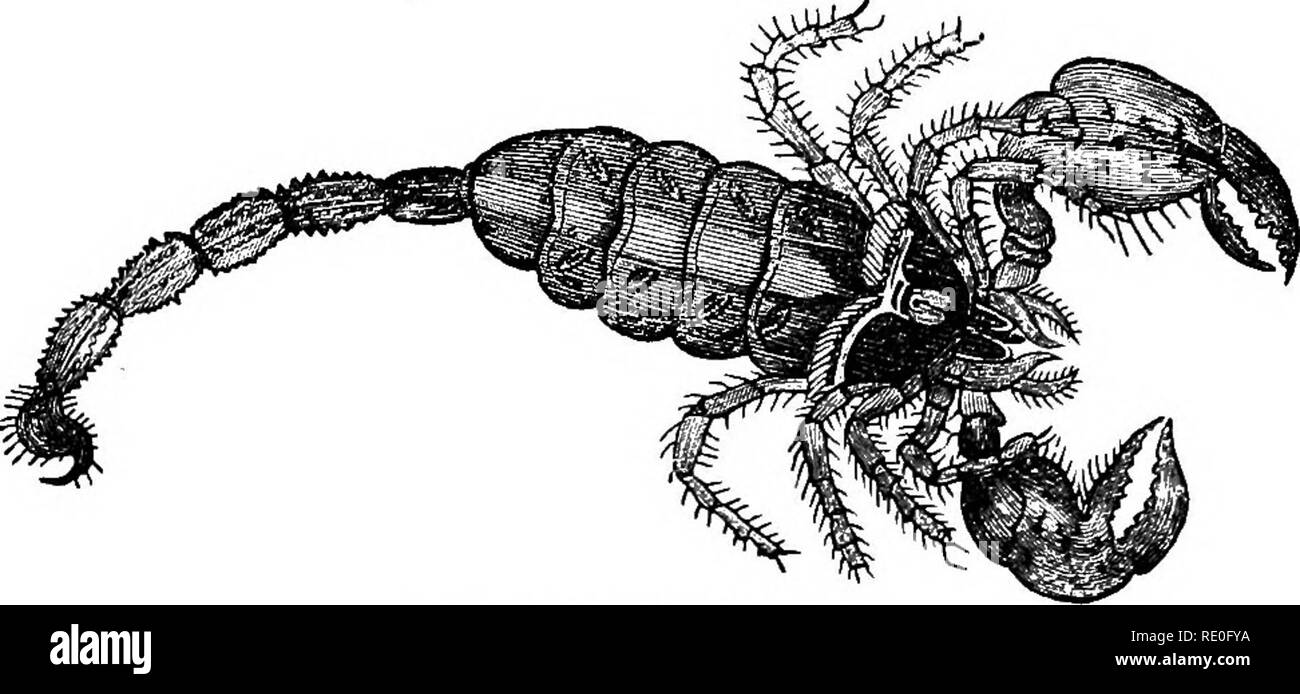. Text-book of zoology for schools and colleges. Zoology. 142 INVERTEBRATE ANIMALS. the true scorpions the end of the abdomen (Fig. 58) is com- posed of a hooked telson, which is perforated for the duct of a poison-gland, situated at its base. It is by means of this that the scorpions sting; and the poisonous fluid which they secrete. Fig. 58.—Scorpion (reduced). is sufficiently powerful to render their wounds troublesome and painful, if not positively dangerous. The mandibles in the scorpions, as already said, are developed into pincers, and the so-called " maxillary palpi" constitu

Image details
Contributor:
The Book Worm / Alamy Stock PhotoImage ID:
RE0FYAFile size:
7.1 MB (320 KB Compressed download)Releases:
Model - no | Property - noDo I need a release?Dimensions:
2318 x 1078 px | 39.3 x 18.3 cm | 15.5 x 7.2 inches | 150dpiMore information:
This image is a public domain image, which means either that copyright has expired in the image or the copyright holder has waived their copyright. Alamy charges you a fee for access to the high resolution copy of the image.
This image could have imperfections as it’s either historical or reportage.
. Text-book of zoology for schools and colleges. Zoology. 142 INVERTEBRATE ANIMALS. the true scorpions the end of the abdomen (Fig. 58) is com- posed of a hooked telson, which is perforated for the duct of a poison-gland, situated at its base. It is by means of this that the scorpions sting; and the poisonous fluid which they secrete. Fig. 58.—Scorpion (reduced). is sufficiently powerful to render their wounds troublesome and painful, if not positively dangerous. The mandibles in the scorpions, as already said, are developed into pincers, and the so-called " maxillary palpi" constitute powerful nipping- claws. The respiratory organs are in the form of pulmonary sacs, four on each side, opening on the under surface of the abdomen by as many distinct apertures or spiracles. The scorpions live in the warmer regions of the temperate zone and in tropical countries, and are generally found hiding under stones or in crevices of walls. Their sting, though much exaggerated, is certainly capable of producing very vm- pleasant symptoms.* Oedek IV. Aeajs^bida.—In this order are the true Spiders, readily distinguished from the insects, with which they are popularly confounded, by having four pairs of legs, as well as by other characters. In all the true spiders (Fig. 59) the seg- ments of the thorax and head are united to form a single mass or cephalo-thorax, to which the soft and unsegmented ab- domen is joined by a constricted stalk, or neck. Respiration is effected by means of pulmonary sacs, usually conjoined with tracheae. The pulmonary sacs are two or four in number, and open on the surface of the abdomen by as many apertures. * Nearly allied to the Scorpions are the Bo-called " Harvest-apidera^' i^PhdlangidcB and the diminutive "Book-scorpion" {Chelfer which is commonly to be found among old books.. Please note that these images are extracted from scanned page images that may have been digitally enhanced for readability - coloration and app